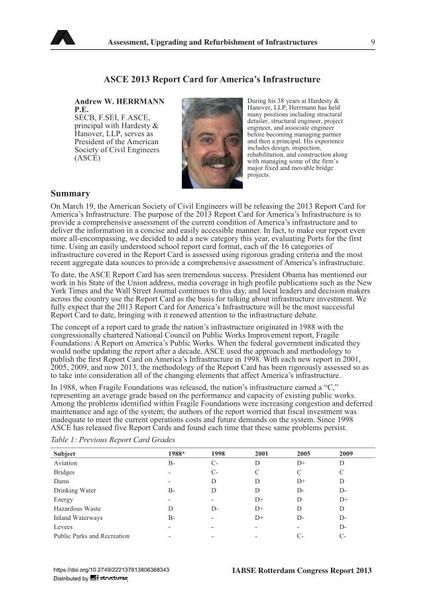Assessment, Upgrading and Refurbishment of Infrastructures: ASCE 2013 Report Card for America’s Infrastructure

|
|
|||||||||||
Bibliographic Details
| Author(s): |
Andrew W. Herrmann
|
||||
|---|---|---|---|---|---|
| Medium: | conference paper | ||||
| Language(s): | English | ||||
| Conference: | IABSE Conference: Assessment, Upgrading and Refurbishment of Infrastructures, Rotterdam, The Netherlands, 6-8 May 2013 | ||||
| Published in: | IABSE Conference, Rotterdam, May 2013 | ||||
|
|||||
| Page(s): | 9-10 | ||||
| Total no. of pages: | 2 | ||||
| Year: | 2013 | ||||
| DOI: | 10.2749/222137813806368343 | ||||
| Abstract: |
During his 38 years at Hardesty & Hanover, LLP, Herrmann has held many positions including structural detailer, structural engineer, project engineer, and associate engineer before becoming managing partner and then a principal. His experience includes design, inspection, rehabilitation, and construction along with managing some of the firm’s major fixed and movable bridge projects. AbstractOn March 19, the American Society of Civil Engineers will be releasing the 2013 Report Card for America’s Infrastructure. The purpose of the 2013 Report Card for America’s Infrastructure is to provide a comprehensive assessment of the current condition of America’s infrastructure and to deliver the information in a concise and easily accessible manner. In fact, to make our report even more all-encompassing, we decided to add a new category this year, evaluating Ports for the first time. Using an easily understood school report card format, each of the 16 categories of infrastructure covered in the Report Card is assessed using rigorous grading criteria and the most recent aggregate data sources to provide a comprehensive assessment of America’s infrastructure. To date, the ASCE Report Card has seen tremendous success. President Obama has mentioned our work in his State of the Union address, media coverage in high profile publications such as the New York Times and the Wall Street Journal continues to this day, and local leaders and decision makers across the country use the Report Card as the basis for talking about infrastructure investment. We fully expect that the 2013 Report Card for America’s Infrastructure will be the most successful Report Card to date, bringing with it renewed attention to the infrastructure debate. The concept of a report card to grade the nation’s infrastructure originated in 1988 with the congressionally chartered National Council on Public Works Improvement report, Fragile Foundations: A Report on America’s Public Works. When the federal government indicated they would notbe updating the report after a decade, ASCE used the approach and methodology to publish the first Report Card on America’s Infrastructure in 1998. With each new report in 2001, 2005, 2009, and now 2013, the methodology of the Report Card has been rigorously assessed so as to take into consideration all of the changing elements that affect America’s infrastructure. In 1988, when Fragile Foundations was released, the nation’s infrastructure earned a “C,” representing an average grade based on the performance and capacity of existing public works. Among the problems identified within Fragile Foundations were increasing congestion and deferred maintenance and age of the system; the authors of the report worried that fiscal investment was inadequate to meet the current operations costs and future demands on the system. Since 1998 ASCE has released five Report Cards and found each time that these same problems persist. |
||||
